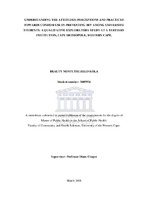| dc.contributor.advisor | Cooper, Diane | |
| dc.contributor.author | Kola, Beauty Nontuthuzelo | |
| dc.date.accessioned | 2018-04-18T09:29:14Z | |
| dc.date.available | 2018-04-30T22:10:07Z | |
| dc.date.issued | 2018 | |
| dc.identifier.uri | http://hdl.handle.net/11394/5969 | |
| dc.description | Magister Public Health - MPH (Public Health) | |
| dc.description.abstract | HIV prevalence in South African youth aged 15-24 years was 7.1% in 2012,
and is considered high (Shisana et al., 2014), suggesting that this population is highly
vulnerable to HIV infection. Most students at the Higher Education Institutions (HEIs) fall
within this age range group, and thus may face similar challenges regarding HIV infection
and condom use. HIV prevalence among students in South African HEIs has increased, with
Heeren et al. (2013) highlighting an incline from 2.3% in 2010 to 3.4% in 2012. Therefore,
students remain at considerable risk of contracting HIV. As part of an HIV prevention
initiative of Higher Education South Africa (HESA), the Cape Peninsula University of
Technology (CPUT) has an HIV/AIDS prevention programme offering a wide variety of
services aimed at preventing, controlling and managing HIV/AIDS among its students. A key
component of this programme is condom promotion, intended to reduce unprotected sexual
intercourse, and hence the risk of HIV transmission. Despite these programmes, the annual
HIV incidence rate among students at the institution appears to have increased, from 0.2% in
2013 to 1.0% in 2015. The increase in HIV incidence suggests issues around the uptake and
use of condoms. | |
| dc.language.iso | en | |
| dc.publisher | University of the Western Cape | |
| dc.title | Understanding the attitudes, perceptions and practices towards condom use in preventing HIV among university students: A qualitative exploratory study at a tertiary institution, Cape Metropole, Western Cape. | |
| dc.rights.holder | University of the Western Cape | |

